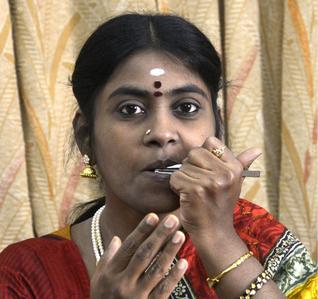Inspired by her father, Bhagyalakshmi took tomorsing and is going places
Women percussion instrument players are few and far between. Rarer are women playing a percussion-twang instrument like morsing. Vijayanagar resident Bhagyalakshmi M. Krishna is, perhaps, the only woman performer of morsing in Karnataka.
Renowned vocalist M. Balamuralikrishna, when he met her in 2006 in Chennai, had told her that she was the first woman morsing player he had met in his long musical career.
Father’s legacy
Bhagyalakshmi taking to the art is no surprise, considering that she is the daughter of the legendary morsing player Bheemachar. She recalls with fondness that her father was a big source of inspiration with a progressive attitude at a time when percussion playing was not regarded a woman’s forte.
He was happy to bring Bhagyalakshmi too into the world of laya , just as he had trained both his sons Dhruvaraj and Rajashekar, both well-known percussionists today.
“When renowned percussionist H.P. Ramachar’s revolutionary experimentation, Karnataka Mahila Laya Madhuri ensemble, had brought in women for mridanga, khanjira, ghata, thavil and konakkol, only morsing was missing. Ramachar’s plea to teach me the art of morsing not just saw my father start the lessons almost immediately, but his conscientious effort enabled me to absorb the nuances like a blotting paper. I was on the dais even as I was a sixth standard student,” she recalls. Thirty-eight-year-old Bhagyalakshmi, a resident of Govindarajnagar in Vijayanagar area, holds a B.Sc. in Electronics.
She is happy that her father brought in some radical changes in his morsing schooling as the “sol-kattu” or percussion syllables he used was stretched with precision and lucidity.
“He believed that clear verbal expressions of laya (the art of konakkol) helped transform the beats onto morsing more effectively. To the lyrical flow of the instrument sheltered in the traditional Pudukottai styling, my father brought in innovative embellishments. What gave it the true ‘Bheemachar stamp’ was the ‘kirra’ sound generally heard from the dhol that was infused into morsing to bring in a dramatic effect,” she explains.
Travels abroad
Bhagyalakshmi, through Mahila Laya Madhuri, travelled to Egypt, Algeria and Tunisia on a concert tour through the ICCR. If that was the starting point, today, as a member of the popular Stree Taal Tarang steered by ghata artiste Sukanya Ramgopal, she has toured extensively through the length and breadth of the nation and globe, and has participated in more than 1,000 concerts and accompanied star performers of the Carnatic genre.
Bheemachar’s Morsing Tarang also had the entire family of four percussionists travel to Amsterdam to take part in the global Jew’s Harp Fest.
“It’s a treat to represent India and present the Indian harp,” she says. Morsing, used in Rajasthan folk music, is called ‘murchang’ there, while the same instrument exists in Germany, Hungary, Japan, Vietnam and Russia under different names that come together during international harp fests.
Says Bhagyalakshmi: “Only when we go abroad and participate in percussion ensembles do we realise the importance this small instrument enjoys. It’s comforting that our own Laya Vadya ensembles have helped morsing to gain more importance. Gender bias is also fading out.”
A knack
On the question of whether morsing can seriously hurt the tongue, she says: “It’s an art you get used to. There is a knack in making music by holding this instrument made of mild steel between your tongue and lips.”
Bhagyalakshmi is now a regular at the Music Academy, Chennai, concerts. This year, during the December season concerts, she will be beside Bangalore’s renowned music guru Neela Ramgopal.
source: http://www.thehindu.com / The Hindu / Home> National> Karnataka / by Ranjani Govind / November 12th, 2013
